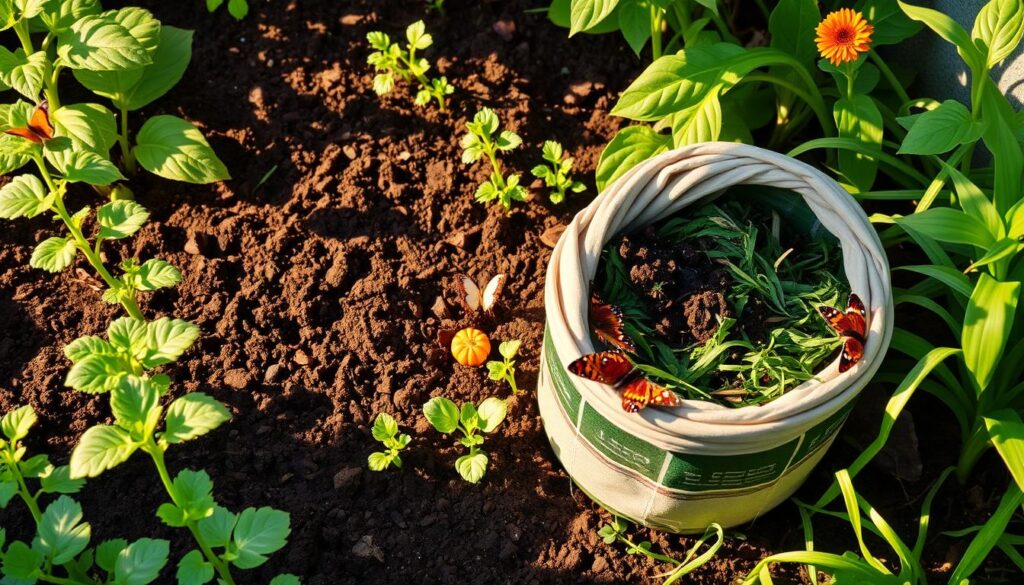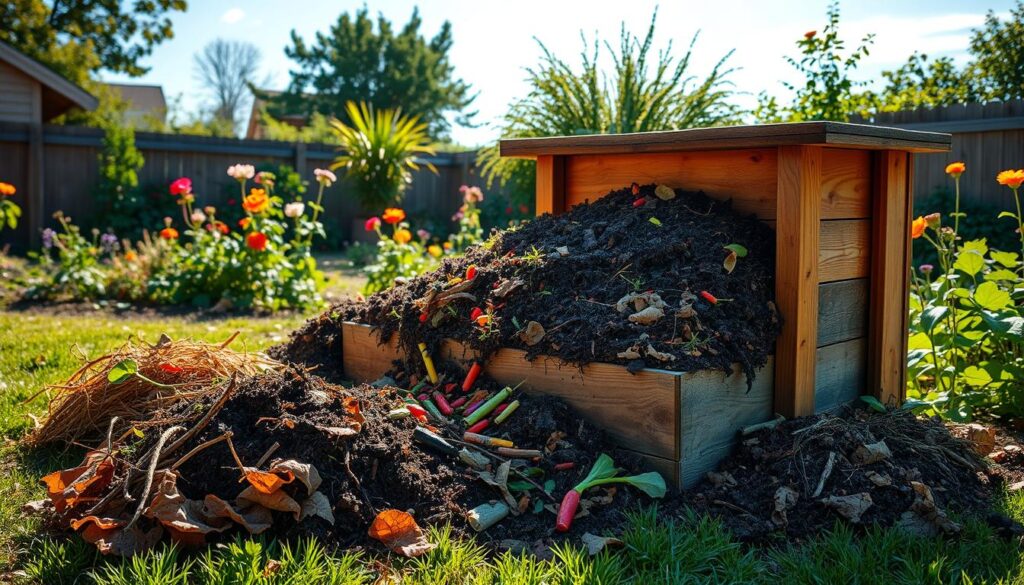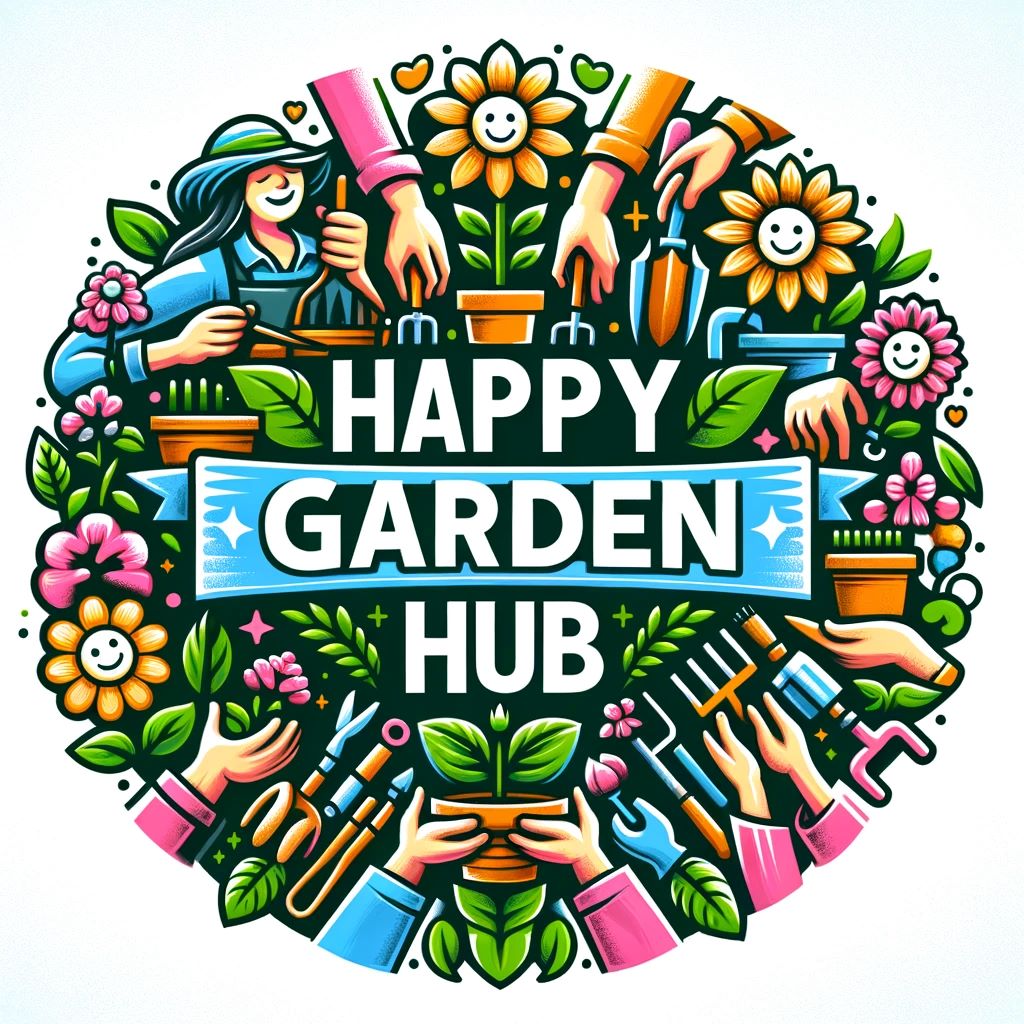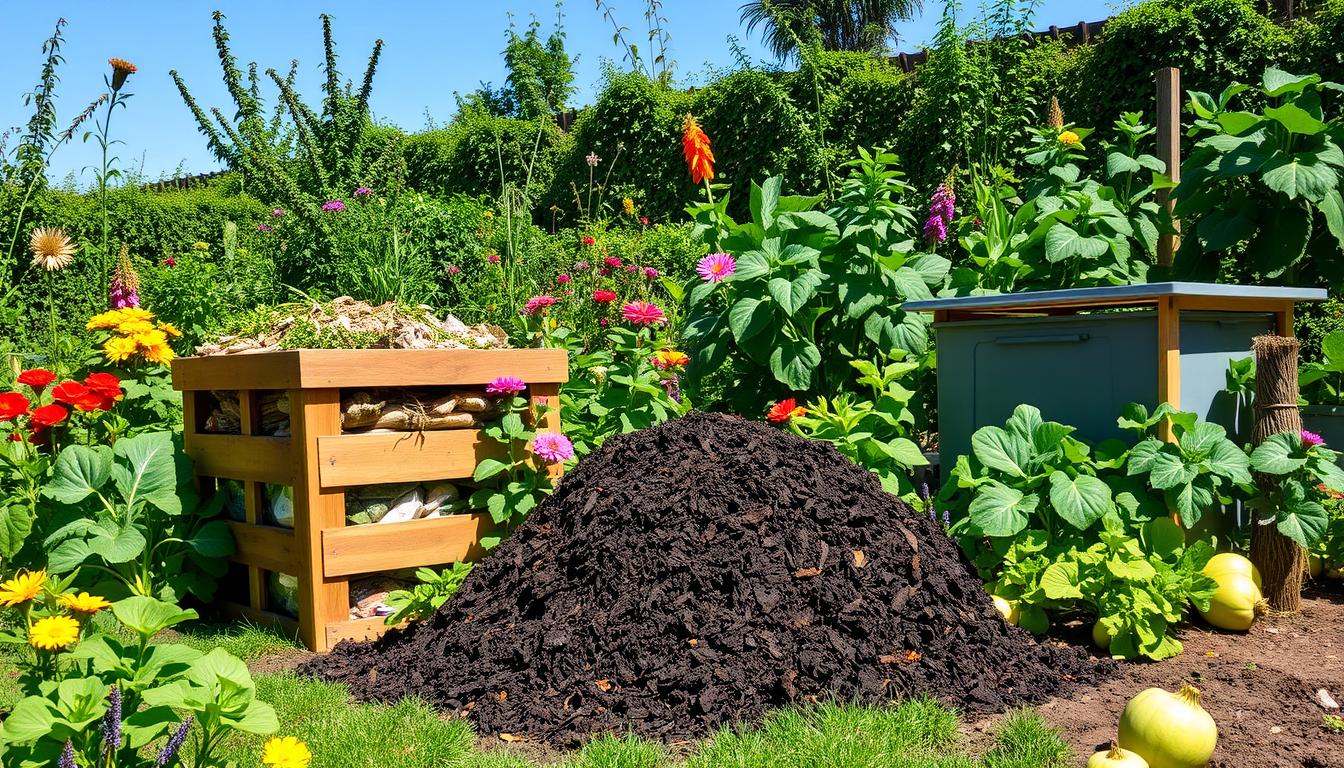This post contains affiliate links.
Ever feel guilty when you throw away a banana peel or grass clippings? These small actions add up, leading to a lot of waste in landfills. This waste produces methane, a gas worse than carbon dioxide. As we face climate change, it’s key to know how we can help.
Composting at home is more than recycling. It’s a way to help our planet and improve soil. By using composting methods at home, we can make a difference. We can help our future be more sustainable.
This guide will show you how to compost at home. You’ll learn how to turn kitchen scraps and yard waste into compost. This compost helps gardens grow and reduces methane emissions. It also makes ecosystems healthier. For more on composting basics, check out this composting 101 article.
Key Takeaways
- Home composting transforms organic waste into nutrient-rich compost essential for healthy gardens.
- Proper composting significantly reduces harmful methane emissions.
- Understanding the balance of green and brown materials is key to successful composting.
- Multiple composting methods are suitable for different living environments.
- Maintaining moisture and aeration enhances the efficiency of composting.
- Composting promotes ecological awareness and encourages sustainable living practices.
What Is Home Composting?
Home composting turns organic waste into nutrient-rich compost. This helps a lot with sustainable living. It involves breaking down kitchen scraps, yard waste, and other biodegradable stuff. Microorganisms make these materials into a great soil amendment.
To compost well, you need the right mix. This mix includes greens, like veggie scraps, and browns, like dried leaves. Aim for 2 to 3 parts brown to 1 part green for best results.
Composting at home cuts down on landfill waste. It also makes soil healthier. This boosts soil’s microbial life and fertility.
There are many ways to compost at home. You can do it in your backyard or indoors, depending on your space and needs. Knowing these options helps you live more sustainably.
Benefits of Home Composting
Home composting brings many benefits for gardens and the environment. It turns organic waste into valuable compost. This reduces the amount of waste in landfills.
Compost makes soil rich in nutrients, helping plants grow better. Studies show plants grow faster in composted soil. This helps them absorb more carbon dioxide.
Composting also means less use of harmful chemicals. Plants become stronger and less dependent on chemicals. This makes the soil healthier and more productive.
Composting helps fight climate change by reducing methane emissions. It cuts down on waste sent to landfills. This lowers our carbon footprint and supports green gardening.
In short, composting is good for more than just gardens. It improves soil, reduces waste, and promotes a greener community.

Choosing the Right Composting Method for Your Home
Choosing the right composting method is key for managing organic waste at home. Several factors influence this choice, like space, waste volume, and personal preferences. Home composting techniques vary, fitting different environments and needs.
For those with outdoor space, backyard composting like traditional piles or bins is great. These need a mix of brown and green materials. Hot composting is fast, often making compost in 14 to 21 days.
Those with little outdoor space might look into vermicomposting for indoor composting with worms. Bokashi bins and worm farms are also good for small spaces. Aerobic methods are better for the environment, as they produce less harmful emissions than anaerobic ones.
Looking at the pros and cons of home composting techniques helps find the best fit. Here’s a table comparing popular methods:
| Composting Method | Space Required | Time to Compost | Maintenance Level |
|---|---|---|---|
| Traditional Backyard Composting | Medium to large | 3-6 months | Medium |
| Hot Composting (e.g., Berkeley Method) | Medium to large | 14-21 days | High |
| Vermicomposting | Small | 2-3 months | Low |
| Bokashi Composting | Small | 2-4 weeks (initial stage) | Medium |
| Static Piles | Medium to large | 1-3 years | Low |
When picking a composting method, think about your space and lifestyle. The right method makes managing organic waste easy and productive at home.
Composting Methods for Home
Exploring effective composting methods at home can significantly minimize waste and enrich garden soil. Homeowners have various options to choose from, making it easier to find a solution that fits their space and lifestyle.
Traditional Composting Techniques
Traditional composting involves creating a compost pile or utilizing a dedicated compost bin outdoors. This method enables homeowners to combine carbon-rich browns, such as leaves and straw, with nitrogen-rich greens, like vegetable scraps. A balanced mix promotes efficient decomposition and creates high-quality compost within several months.
Hot composting, a popular traditional technique, can generate temperatures between 130-170°F and yield compost in just six to eight weeks. For those looking to maximize the composting process, a healthy C:N ratio is essential. The ideal ratio is 30:1, with a range from 25:1 to 40:1 to foster optimal microbial activity.
Indoor Composting Solutions
Indoor composting offers a solution for those with limited outdoor space, allowing users to compost kitchen scraps in a more compact environment. Methods such as vermicomposting utilize red wriggler worms to break down waste, producing rich compost without unpleasant odors. Additionally, other indoor options include various types of compost bins designed for small spaces.
These bins can accommodate a variety of materials, making it easier to divert kitchen waste from landfills and contribute to the overall composting cycle. Utilizing strategies like trench composting, where kitchen waste is buried, can further enhance soil fertility in both outdoor and indoor garden environments.
| Composting Method | Location | Time to Compost | C:N Ratio |
|---|---|---|---|
| Traditional Composting | Outdoors | 6-8 weeks | 30:1 (ideal) |
| Hot Composting | Outdoors | 6-8 weeks | 25:1 to 40:1 |
| Vermicomposting | Indoors | 2-3 months | 20:1 to 25:1 |
| Trench Composting | Outdoors | Variable | Depends on materials |
Setting Up Your Composting System
Creating a good composting system needs careful planning and the right materials. Choosing the best compost bin is key for efficient decomposition. You can pick from outdoor bins made of wood, plastic, or metal, or compost tumblers for easier aeration.
Best Compost Bin Options
When picking a compost bin, think about size, material, and how easy it is to use. Here are some top choices:
- Traditional Compost Bins: These are usually made of wood or plastic and work well for big gardens.
- Compost Tumblers: Great for quick aeration, these bins make turning compost easy.
- Vermicomposting Bins: Ideal for indoor use, these bins use red wigglers to break down kitchen scraps.
When setting up your compost, layering materials right is key. Mix two parts brown materials with one part green to speed up decomposition. Covering the compost helps keep it warm and moist, perfect for microorganisms.
Vermicomposting Basics
Vermicomposting is great for those with little outdoor space. Start with a bin filled with shredded newspaper or cardboard. It’s important to add red wigglers to break down waste. Make sure the worms have a dark, damp place, and feed them fruit and veggie scraps but avoid meats and dairy.
A well-kept vermicomposting setup cuts down on food waste and gives you nutrient-rich compost for your garden. With the right care, your compost will be dark and crumbly, enriching the soil. For more eco-friendly gardening tips, check out this guide on organic gardening tips.

Maintaining Your Compost
Keeping your compost system in top shape is key. Aeration and moisture control are crucial. They help turn waste into valuable fertilizer.
Aeration and Moisture Control
Aeration brings oxygen to the compost, helping aerobic bacteria work. Turning the pile every two weeks helps break down materials and keeps it aerated. The compost should be as damp as a wrung-out sponge, between 40% and 60% moisture.
Harvesting Your Compost
Knowing when to harvest is important. The compost is ready when it’s cooled down and shrunk to about one-third of its original size. It should look dark and crumbly, ready to enrich your garden. Good compost management leads to nutrient-rich soil for sustainable gardening.
| Factor | Recommendation |
|---|---|
| Aeration Frequency | Turn compost pile at least every two weeks |
| Moisture Level | Maintain 40% to 60% moisture content |
| Compost Temperature | Hot pile should reach at least 130°F (54°C) |
| Finished Compost | Ready when reduced to one-third of original volume |
| Ideal Compost Pile Height | 3.5 to 5 feet |
Troubleshooting Common Compost Problems
Even with careful attention, compost lovers may still face compost issues. Knowing how to solve these composting problems can make compost healthier. This leads to a better garden. It’s important to understand the common issues to fix them right.
Bad smells often mean there’s a problem with the compost pile. Too much green or brown material can cause this. Adding the right mix can fix it. Also, too much water makes the pile soggy and smelly. Turning the pile and adding dry stuff helps.
Materials that don’t break down fast might not have enough air. Or, they might be too big. If it’s too dry, especially in summer, adding wet stuff helps. Green materials like grass clippings speed up the process.
Pests like fruit flies or animals can be a problem. Fruit flies mean the container isn’t sealed well. Use tight lids to keep them out. Avoiding meat and fats keeps skunks and rodents away. This makes composting easier.
| Problem | Cause | Solution |
|---|---|---|
| Odors | Imbalance of greens and browns, excess moisture | Adjust mix, turn pile |
| Slow Decomposition | Insufficient aeration, dry materials | Add nitrogen-rich materials, moisture maintenance |
| Pest Presence | Unsealed containers, fatty foods | Use tight lids, avoid certain foods |
| Excessive Wetness | Too many wet materials | Drain materials, allow drying |
| Texture Issues | Slow breakdown of tough materials | Shred materials before composting |
By tackling these composting problems early, composters can improve their process. With the right care, composting can be a success indoors and outdoors.
Compostable Materials: What You Can and Cannot Compost
Knowing what can go into your compost pile is key to a healthy compost. Food scraps and yard waste make up over 30 percent of our trash. Here are some items to compost:
- Fruit and vegetable scraps
- Coffee grounds and filters
- Eggshells
- Grass clippings
- Dry leaves
- Brown paper products, such as cardboard
- Paper towels and tissues
Experts say to mix your compost with a 2:1 ratio of brown to green materials. Add enough water for it to break down well. Manure from herbivores can also make your compost richer.
But, there are things you shouldn’t compost to keep your pile healthy:
- Dairy products
- Meat and seafood products
- Pet waste and human waste
- Toxic plants and pesticide-treated plants
- Coal ash
- Leaves and twigs from black walnut trees
These items can attract pests and bring harmful pathogens. Following these guidelines helps your compost pile reach the right temperature. This kills off bad organisms.
For more gardening advice, check out Jerry Baker’s tips. Choosing the right materials for composting helps the environment a lot.
Integrating Composting into Your Daily Routine
Adding composting to your daily life can make gardening better and help the planet. Start with kitchen composting. Use a bin in your kitchen to collect food scraps like fruit peels and veggie trimmings. This simple step cuts down on waste and makes great compost for your garden.
For yard waste, like grass clippings and leaves, use an outdoor compost bin. DIY composting turns these into valuable soil for your plants. It’s a simple way to recycle and help your garden grow.
To make compost work well, mix green and brown materials right. Aim for a 30:1 brown to green ratio for fast breakdown. Choose a compost bin that fits your space, from small indoor bins to big outdoor ones.
Knowing what can go into compost is key. Add coffee grounds, eggshells, and shredded paper, but avoid dairy and meat. Learn what’s okay to make your compost system strong.
Composting can become a rewarding part of your daily routine. It’s a natural way to feed your plants and saves money. As more people compost, it becomes more important for a greener garden.
| Type of Material | Compostable? |
|---|---|
| Fruit Scraps | Yes |
| Vegetable Trimmings | Yes |
| Coffee Grounds | Yes |
| Meat and Dairy | No |
| Eggshells | Yes |
| Grass Clippings | Yes |
| Pesticide-treated Wood | No |
By composting, you make your garden better and help the environment. Start with kitchen scraps and use an outdoor bin for yard waste. Enjoy the benefits of turning waste into valuable soil.
Conclusion
Home composting is a smart way to turn waste into valuable soil. It takes a few months to a year to get the best results. This method not only cuts down on landfill waste but also saves money on trash bags.
Studies show that composting can greatly reduce trash in just a week. It’s a simple way to help the environment.
Adding composting to our daily lives shows we care about the planet. It makes our gardens healthier and helps fight climate change. By using food scraps and yard trimmings, we can make a big difference.
Home composting lets us make a real difference in our community. It’s not just about gardening; it’s about caring for our planet. By composting, we’re taking a big step towards a greener world.
FAQ
What materials can I compost at home?
What is vermicomposting and how does it work?
How do I maintain my compost pile?
What should I do if my compost smells bad?
Can I compost in small spaces?
How long does it take to make compost?
Is it necessary to use a compost bin?
What are some common composting mistakes to avoid?
This post contains affiliate links.

